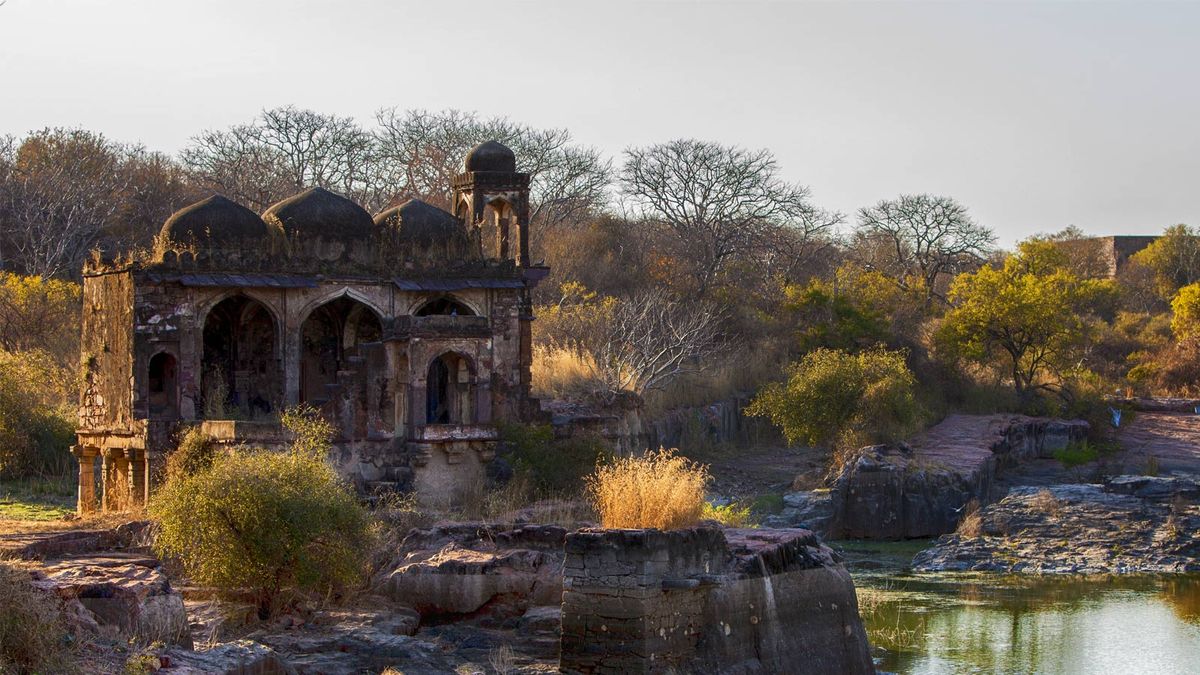Grooving to Mame Khan’s soulful folk numbers, my husband and I are driving on well-kept roads dotted with no-frills dhabas and dal baati joints, medieval forts—some in evocative ruins, stark rocky mountains, and cows roaming freely, unbothered by the traffic. What better than a road trip to savour the rustic splendour of the Land of Maharajas? En route to Sawai Madhopur—Rajasthan’s remote, historic town and a proud gateway to the game-rich Ranthambore National Park—we see cinematic landscapes comprising endless stretches of vibrant mustard and maize fields; clusters of villagers happily hanging from a jugaad (make-shift vehicle); picturesque hamlets waking up at an unhurried pace; old men in white dhotis and colourful pagri squatting outside shops, discussing the news while sipping their tea; women in bright ghaghra cholis gracefully balancing pots of water on their heads and children frolicking in their underpants. Ah, the simple joys of country life!
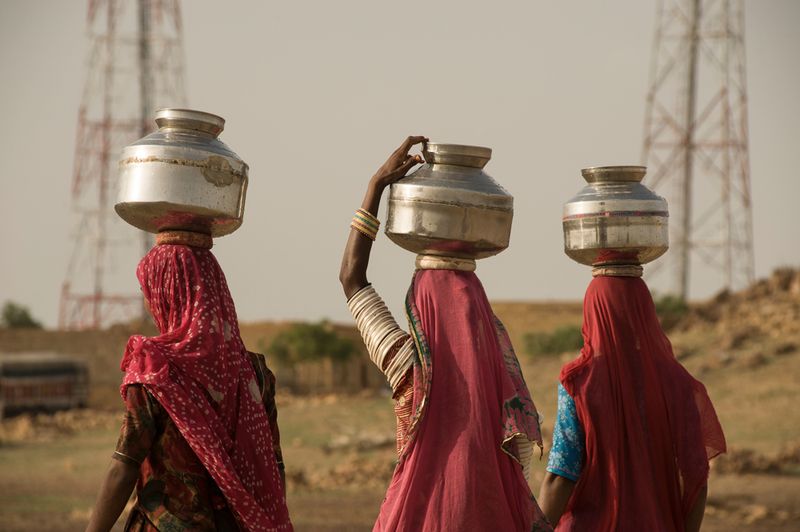
The arrival
We know we have arrived in Sawai Madhopur as soon as we see guava vendors lining the streets and tiger artwork around every corner. With public buildings, schools and independent houses painted in creamy peach and adorned with identical floral designs in burnt umber, the town wears a distinctive personality and appearance. A five-minute driving distance from the town’s centrally-located, artistic railway station (yet away from the busyness of the city) is Zana Forest Ranthambore, Espire Hospitality Group’s newest boutique property and our home away from home for three nights.
Checking in
After a warm welcome, we are escorted to our tastefully designed cottage with a spacious sit-out area and a private garden ideal for soaking up the winter sun. Every cottage is given a name inspired by Victorian culture; think Roger, Wilson, Arthur, Austin and Simon among others. We are staying in Hayden which is a 560 sq ft space boasting a wooden four-poster bed with ethereal white curtains, a convenient work desk, and an exquisite shower area.
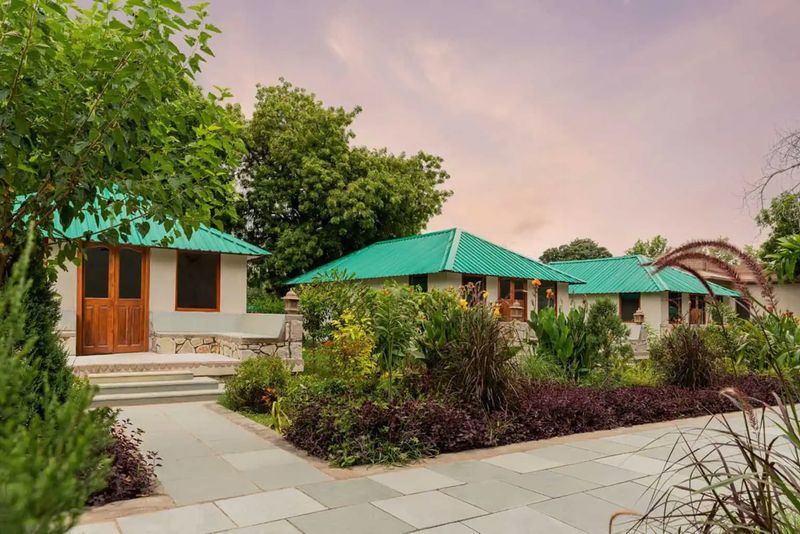
All we wish to do is put our feet up and shake off the weariness from the road trip. As we are about to lounge on the uber-comfortable couch, there’s a knock on the door as we are brought a delish snack tray consisting of coffee, fresh sandwiches, and piping hot samosas. Who doesn't love a little pampering?

Misty winter mornings at Zana Forest Ranthambore are all about waking up to rhythmic birdsongs and religious chanting from the neighbouring temple. A private yoga class conducted by skilled yoga instructor Arun Ji in our garden area sets the tone for the day. Breakfast at Mayfair includes a spread of freshly cut fruits, nuts, seeds and muesli alongside Indian staples like poha, parathas, dosas and omelettes to order. We devour these with a pot of coffee. Hanging out in common areas is an opportunity to bump into other wildlife-enthusiastic guests as well as the friendly resort staff; this often leads to an exchange of interesting stories and quick dope on zones where tiger sightings have been plenteous, lending an edge to our upcoming safari.
A ride in the wild
It’s 2.30 pm and time for our much-awaited forest adventure. Hoping it turns into a spontaneous date with Ranthambore’s wild cats, we are dressed in our stylish beige and olive-green safari outfits and equipped with all possible gear we might need to capture the precious moment. We quickly hop into the Gypsy that arrives at the resort entrance. We have a driver and a forest guide as well as two travellers from Germany sharing the vehicle. Getting to Zone 8 of Ranthambore National Park requires one to drive through a narrow, dusty road with a few brick houses sprinkled on both sides. Groups of children excitedly run beside our gypsy while village belles sporting vibrant, embellished garb lift their ghoonghats for a moment and wave at us coyly. Our driver says they are dressed to attend a traditional wedding ceremony.

After getting our IDs verified at the entrance of Zone 8, we are finally in the raw and mystical Ranthambore National Park which derived its name from the monumental Ranthambore fortress that sits deep within. While the vast sanctuary is popular for its rising population of Bengal tigers, it is also home to abundant spotted deer, sambar deer, nilgais, langurs, jackals, foxes, sloth bears, and the elusive Indian leopards and hyenas. To delight the birdwatchers and ornithologists, there are around 320 species of feathered friends including serpent eagle, waterfowl, cormorant, painted spurfowl, bronzed-winged jacana, sandpiper, kingfisher, nightjar, painted sandgrouse, and great-horned owl.
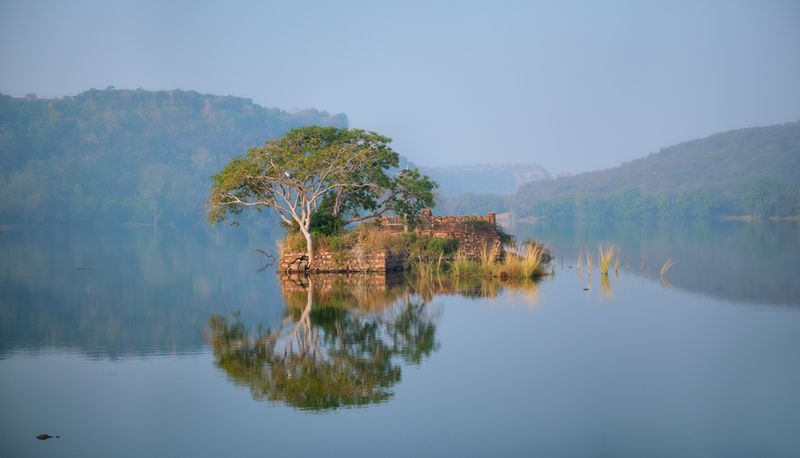
Having toured several Indian jungles, we realise the topography of the Ranthambore forest, once a royal hunting ground for the Maharaja Sawai Man Singh II of Jaipur, is vividly varying and unique in many ways. Undulating, scrubby hills, grasslands, ravines, lakes, water holes and antiquated architectural elements like Indo-Islamic chattris (dome-shaped elevated pavilions), jharokhas, and ancient temples—all packed in an area of 1,334 sq km.
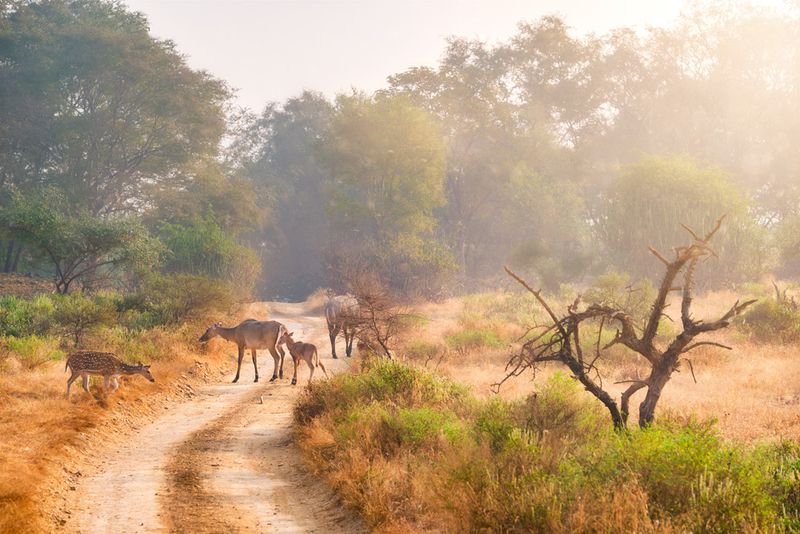
Making our way through the narrow, bumpy pathways, our eyes are peeled for the shy and dominant Laadli (T-8), the queen of Zone 8. Our expert driver has a finger on the pulse of everything; from where the tigress and her cubs have been roaming lately to her latest fight with a male tiger. He says the presence of a tiger changes the jungle around it. So, we’re all paying close attention to alarm calls by birds, deer, and langurs; it’s the best way to know whether there is any predator movement in the vicinity. Following a few pugmarks, we arrive at a spot overlooking the valley and patiently wait for Laadli to make an appearance. With the forest as his workplace for 19 long years, our sociable driver amuses us with his tiger tales. “Ranthambore tigers are special because of the ease with which they coexist with us humans. They confidently roam the jungles, unaffected by camera shutters, human sounds and the rumbling of the safari vehicles. They often use the jeep tyres for an ambush,” he says.
Since Zone 8 of the forest falls under the buffer area, the chances of a sighting are slim, our guide explains. At the same time, it is an arid expanse which makes it easier to spot a tiger. Our time in the forest is almost over and there are no signs of the striped cat.
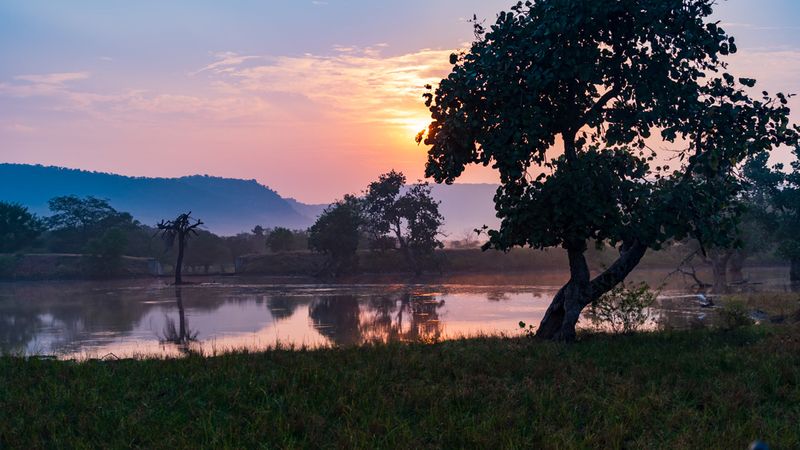
Appreciating the magical orange-pink sunset sky, we remind ourselves that tiger spotting is a game of pure luck. Perhaps, the mantra to a blissful safari experience is “Keep your hopes high and your expectations low”. Our rendezvous with the king of Ranthambore remains pending but the thrill of the safari and the beauty and scents of the jungle will stay with us for the rest of our lives.
Winding down
Back at the resort, we spend the evening experiencing Zana’s signature Liquor and Liqueur tasting session alongside a chef’s choice dinner in an atmospheric nook spruced up with candles. Zana Forest Ranthambore is attuned to hospitality wrapped in warmth. For lunch and dinner, both Western and Indian cuisines are on offer and one can either order in or choose to eat at the Mayfair all-day dining restaurant with refreshing interiors. One can pick something light like soups, salads, pasta dishes and sandwiches, try their Asian specialities like Wok-tossed Tofu and Pho Pia Je (Thai-style spring rolls) or savour all-time favourite tikkas and curries alongside crisp tandoori rotis. Those who prefer intimacy in seclusion can also request an outdoor meal experience by the pool.
More than the cats…
There is a lot more to Sawai Madhopur than tigers. So, we decided to spend the next day exploring the 5th-century Ranthambore Fort, a UNESCO World Heritage Site that is perched atop a 700-foot-high hill, bang in the middle of the forest. The drive to the fort is both scenic and splendid. We see countless peacocks, crocodiles basking in the sun, and a few rare bird species. Our driver says one can even spot a tiger on the way to the monument!
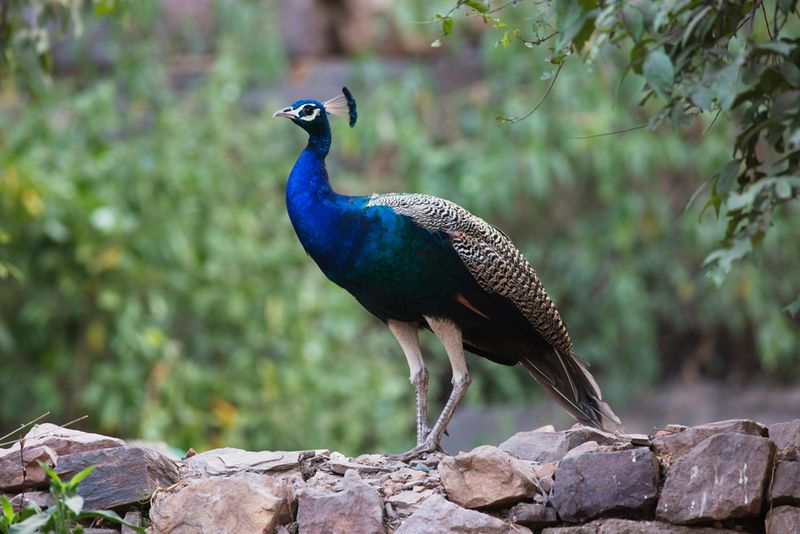
We meet our guide in the dedicated parking area and start walking uphill towards the fort entrance guarded by troops of prankish langurs. “A powerful independent kingdom in early medieval times, Ranthambore controlled trade routes between North India and Central India. Sitting in the heart of this kingdom, the massive Ranthambore Fort was the site of the first-ever settlement in the region, with a thriving community living around it. While its strategic location did play a major role in keeping the enemy at bay, many battles were fought here,” explains the guide.
Stepping back in time at Ranthambore Fort
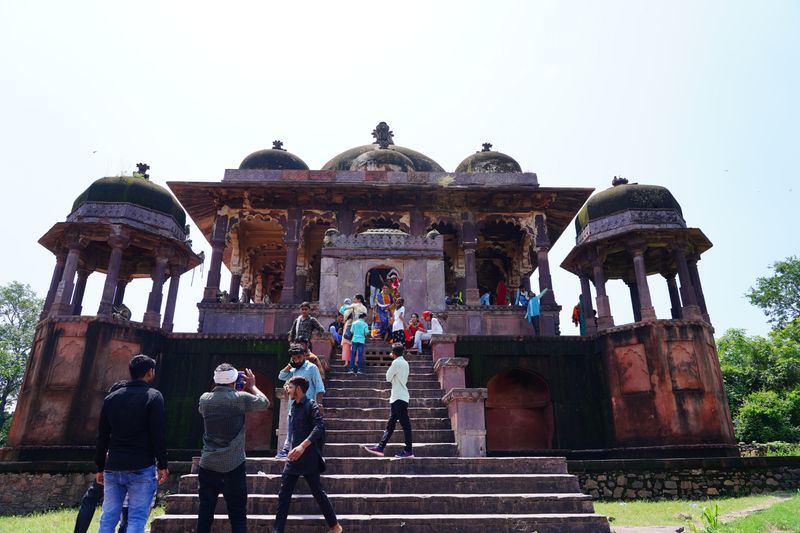
Built by the Chauhans, the fort spreading over an area of 7 km in circumference looks as if it is jutting out of a rock. The fort complex is characterised by enormous gates, stone walls studded with bastions and turrets, and a network of lanes and courtyards dotted with palaces, cenotaphs, tanks, pavilions, temples and a mosque.
Legend says several royal women of the Chauhan dynasty performed jauhar (self-immolation) at this very fort when the Muslim invader Alauddin Khilji laid siege to it in 1303. The fort changed hands many times over the next three centuries until Mughal emperor Akbar captured the fort and dissolved the state of Ranthambore in the middle of the 15th century.
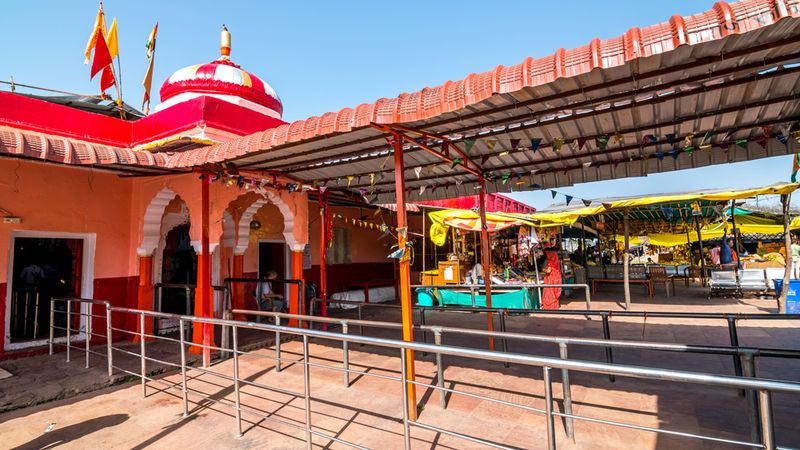
A must-visit is the revered Trinetra Ganesha temple housed within the complex. The idol is said to have appeared miraculously out of a wall during the reign of King Hammir Dev Chauhan in 1300 AD. We spend some quiet moments absorbing the divinity and performing a little prayer that ends with the priest chanting some mantras and tying the holy thread around our wrists. A local playing nagada inside the temple adds to its vibe and allure.
Making our way back, we make sure to stop at the many vantage points around the fort to admire the architectural marvel from different angles and photograph the breathtaking forest and lake scenery below.
Know before you go
How to get there: Ranthambore National Park is well connected by road, air, and railway to all the major cities in India. An eight-hour drive (462 km) from Delhi can bring you here. If you’re flying in, consider a plane journey to Jaipur International Airport which is just a three-hour drive (181 km) from Ranthambore. You can also take a train straight to Sawai Madhopur Railway Station which is 8 km from the main entry gate.
Best time to visit: The blistering summer months (from April to June) are the best time for wildlife spotting; this is when tigers as well as other animals are on the move and often found resting around water bodies. If you wish to enjoy great weather and greenery, plan a visit between October to March. Monsoon stays from July to September and the park is closed during this time.
Where to stay: Zana Forest Ranthambore, the newest family-friendly boutique resort in Sawai Madhopur, offers all the creature comforts along with delish meals and ample ways to while away your time in between safaris and sightseeing. Play a friendly match of badminton, have fun with arcade games like basketball and air hockey, get nostalgic over a few some board games in the comfort of your room or slip into the resort’s large, inviting swimming pool. A personal bonfire and a cup of hot chocolate are just a call away. The team arranges yoga sessions as well as outdoor meal experiences that can be tailored to your needs and specifications.
Tariff starts: Rs 15,000++ with breakfast for two
https://zanaresorts.com/zana-forest-resort-ranthambore/
What to shop
Head to Tribal Women Craft to pick stunning tiger paintings, safari jackets and hats, souvenir tees and magnets, block-printed fabrics with cute designs like tiger paws, camels, elephants and more, cotton block-printed shirts, winter jackets and kurtas, handmade rugs, ethnic bags, paw-shaped brass ashtrays among other décor and fashion items. At first glimpse, the store may appear like a tourist trap but their prices are quite affordable. Moreover, the revenue from locally-made handicrafts goes straight to the artisans. The shop has its little block-printing unit where you can catch the block printers in action.
Where: Tribal Women Craft, H1-20, Riico Industrial Area, Ranthambore Rd.
Safari basics
- While there are both canter and jeep safaris available at the Ranthambore National Park, opt for the private or shared jeep which helps navigate winding roads, increasing your chances of sighting varied wildlife.
- The three-hour-long safari happens twice a day—morning and evening, and the timings for the safari slots vary as per season.
- Zones one to five are well-maintained and considered the best in terms of sightings. Zones six to 10 are buffer zones.
- There are more than 200 guides at Ranthambore National Park. Your jeep and guide are assigned as per the roster maintained by the park officials. If you wish to pick a guide, you must pay an additional fee
- You can book the safari online on the Rajasthan government website which could seem like a tedious task for a first timer. Alternatively, you can ask your resort to book it for you. Resort prices could be slightly higher though. Make sure to book at least two safaris; morning and evening each.
- Jeep safari rates on the official website are INR 897 for Indians and INR 1,637 for foreigners. For children under the age of five, it is free.
Sawai Madhopur Railway Station, a must-visit for art lovers
Even if you aren’t travelling by train, make sure to visit the railway station for a look at the ceilings and walls depicting Ranthambore’s diverse fauna in its natural habitat, including beautifully rendered scrub jungles, banyan trees, leopards, bears, darters, tree-pies, and the fabled tigers. The gorgeous artwork ideated by conservationist Valmik Thapar along with WWF India, and created by local artists makes for a pleasant surprise!


